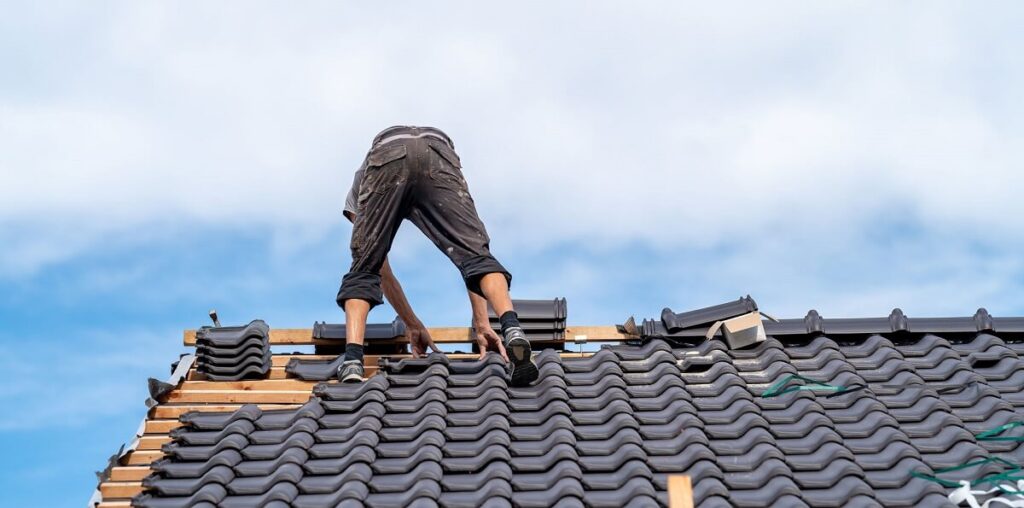A qualified roofing contractor is adept at installing multiple types of roofing materials. These materials are available in different grades, or qualities, allowing them to be used for a wide range of cost projections. To illustrate, we will briefly explore the quality materials used by roofers.
The Different Types of Shingles
A roofing contractor offers several types of shingles that cater to different preferences, climates, and budget considerations. Asphalt shingles, the most common and affordable option, offer versatility in colors and styles. Wood shingles, prized for their natural aesthetic, provide durability and insulation benefits but may require more maintenance. Metal shingles are known for their excellent longevity, energy efficiency, and resistance to harsh weather conditions. Tile shingles, crafted from materials like clay or concrete, present a distinctive appearance with excellent durability and fire resistance, although they can be heavier and may require specific roof structures. Finally, slate shingles, a premium choice esteemed for elegance and longevity, offer natural beauty and resistance to weathering, making them ideal for those willing to invest in high-end roofing material.
Alternative Roofing Materials
When considering roofing materials, a range of alternatives caters to diverse preferences, environmental concerns, and budget considerations:
- Sustainable Options – Materials like recycled metal and reclaimed wood contribute to environmentally friendly practices, offering durability and a unique aesthetic.
- Solar Shingles – Combining energy efficiency with roofing, these shingles generate electricity from the sun, blending seamlessly with traditional roofing materials.
- Rubber Roofing – Made from recycled materials, rubber shingles provide durability, energy efficiency, and resistance to extreme weather conditions.
- Green Roofs – Incorporating living vegetation atop roofs enhances insulation, absorbs rainwater, and contributes to environmental sustainability.
- Clay Tiles – Known for their durability and classic appearance, clay tiles are resistant to fire, mold, and rot, making them a timeless and aesthetically pleasing choice.
Each alternative material aligns with specific priorities, allowing homeowners to make informed choices based on factors such as sustainability, energy efficiency, and design preferences.
How the Contractor Selects Materials
Selecting the right roofing materials is a pivotal decision that involves considering various factors to meet both functional and aesthetic needs. Begin by assessing the climate of your location, as different materials offer varying levels of durability against weather conditions such as rain, snow, or extreme heat. Budget considerations are essential, as roofing materials come in a wide price range. Balancing cost with longevity and maintenance requirements is crucial for a well-informed decision. Additionally, consider the architectural style of your home and any neighborhood restrictions or guidelines that may influence your choice. Aesthetic preferences play a significant role, as the appearance of your roof contributes to the overall curb appeal of your property.
Enlisting the expertise of a roofing contractor is invaluable in navigating the complexities of selecting the right materials. Professional contractors bring industry knowledge and experience, guiding homeowners through the myriad options available. They assess the unique needs of the property, considering factors like slope, ventilation requirements, and load-bearing capacity. Roofing contractors can provide insights into the benefits and drawbacks of various materials, helping homeowners make informed decisions aligned with their priorities. With their familiarity with local building codes and regulations, contractors ensure that the chosen materials comply with standards, providing both durability and peace of mind. Collaborating with a roofing contractor not only streamlines the decision-making process but also contributes to the successful implementation of the chosen roofing materials, ensuring longevity and performance.
Options for Eco-Friendly Roofing Options
A growing emphasis on sustainability has led to the emergence of eco-friendly options that offer both environmental benefits and energy efficiency. One popular choice is solar roofing, integrating photovoltaic cells into traditional roofing materials. Solar shingles, in particular, seamlessly blend with standard roofing materials while harnessing the sun’s energy to generate electricity. This eco-friendly alternative not only reduces dependence on traditional power sources but also contributes to lower utility bills over time. Additionally, the use of recycled materials in roofing options like recycled metal or reclaimed wood minimizes waste and provides a durable and aesthetically pleasing solution. These materials offer a second life to resources, aligning with environmentally conscious construction practices.
Green roofs represent another eco-friendly roofing option that goes beyond conventional materials. Green roofs enhance insulation, reducing energy consumption for heating and cooling. They also absorb rainwater, mitigating runoff and reducing the strain on stormwater systems. Beyond functionality, green roofs contribute to urban biodiversity by creating habitats for birds and insects. Consulting with a knowledgeable roofing professional can help homeowners explore the most suitable eco-friendly options based on their specific needs and preferences.
Tips for Roof Care
Proper maintenance is paramount to ensuring the longevity and performance of a roof, safeguarding the home’s structural integrity. Regular inspections are a fundamental aspect of roof maintenance, allowing homeowners to identify and address potential issues before they escalate. Cleaning gutters and downspouts is crucial to prevent water accumulation, which can lead to roof leaks and water damage. Trimming overhanging branches helps minimize the risk of fallen debris and allows for adequate sunlight and air circulation, crucial for preventing the growth of moss or algae. Additionally, addressing any damaged or missing shingles promptly is essential to preserve the roof’s protective barrier. Professional roof inspections, ideally conducted annually or after severe weather events, provide a comprehensive evaluation of the roof’s condition. A proactive approach to roof maintenance not only extends the lifespan of the roofing system but also contributes to a home’s overall resilience and value.
Choosing the right roofing materials involves considering factors like climate, budget, and aesthetic preferences. Reputable roofing contractors play a pivotal role in assisting homeowners with these decisions, providing expertise and ensuring compliance with local building codes. Exploring eco-friendly roofing options, such as solar roofing and green roofs, aligns with sustainable construction practices and offers both environmental benefits and energy efficiency. Proper maintenance is crucial for preserving the integrity of a roof, involving regular inspections, gutter cleaning, branch trimming, and addressing any damaged or missing shingles promptly. Overall, the diverse aspects covered emphasize the importance of informed decision-making, collaboration with professionals, and a proactive approach to ensure the longevity and resilience of roofing systems.
Peak Roofing & Exteriors
If you’re looking for an honest and experienced roofing contractor that can handle your home or business roofing needs in Northwest Arkansas, Northeast Louisiana, or West Texas, look no further. Peak Roofing & Exteriors will deliver with quality and integrity. Contact us today and book your FREE inspection!

